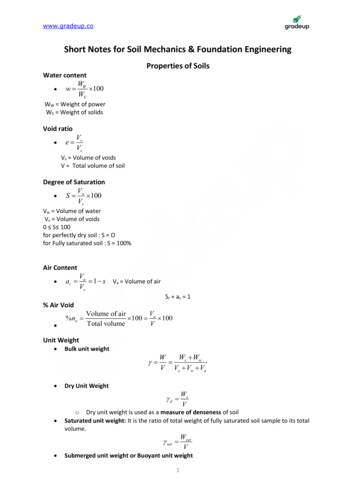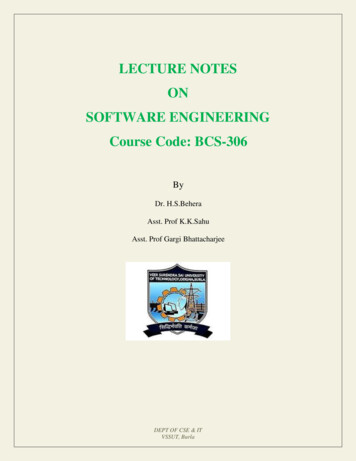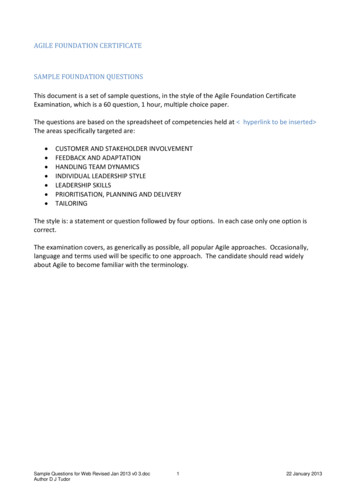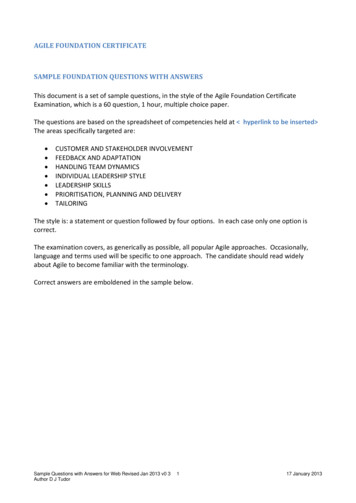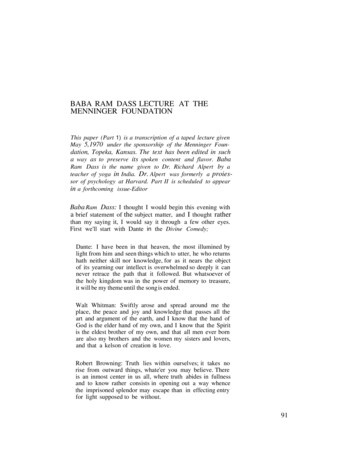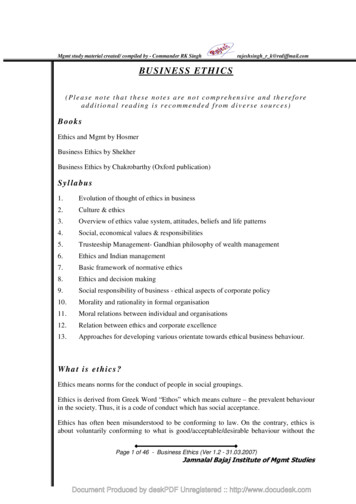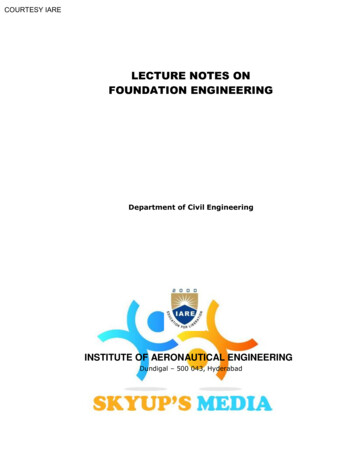
Transcription
COURTESY IARELECTURE NOTES ONFOUNDATION ENGINEERINGDepartment of Civil EngineeringINSTITUTE OF AERONAUTICAL ENGINEERINGDundigal – 500 043, Hyderabad
COURTESY IAREFOUNDATION ENGINEERINGOBJECTIVEAt the end of this course student acquires the capacity to assess the soilCondition at a given location in order to sugest suitable foundation and also gainsThe knowledge to design various foundations.UNIT ISITE INVESTIGATION AND SELECTION OF FOUNDATIONScope and objectives – Methods of exploration-auguring and boring – Water boring androtatory drilling – Depth of boring – Spacing of bore hole - Sampling – Representativeand undisturbed sampling – sampling techniques – Split spoon sampler, Thin tubesampler, Stationary piston sampler – Bore log report – Penetration tests (SPT andSCPT) – Data interpretation (Strength parameters and Liquefaction potential) –Selection of foundation based on soil condition.UNIT IISHALLOW FOUNDATIONIntroduction – Location and depth of foundation – codal provisions – bearing capacity ofshallow foundation on homogeneous deposits – Terzaghi’s formula and BIS formula –factors affecting bearing capacity – problems - Bearing Capacity from insitu tests (SPT,SCPT and plate load) – Allowable bearing pressure, Settlement – Components ofsettlement – Determination of settlement of foundations on granular and clay deposits –Allowable settlements – Codal provision – Methods of minimising settlement, differentialsettlement.UNIT IIIFOOTINGS AND RAFTSTypes of foundation – Contact pressure distribution below footings and raft - Isolatedand combined footings – Types and proportioning - Mat foundation– Types, applicationsuses and proportioning-- floating foundation.UNIT IVPILESTypes of piles and their function – Factors influencing the selection of pile – Carryingcapacity of single pile in granular and cohesive soil - Static formula - dynamic formulae(Engineering news and Hiley’s) – Capacity from insitu tests (SPT and SCPT) – Negativeskin friction – uplift capacity – Group capacity by different methods (Feld’s rule,Converse Labarra formula and block failure criterion) – Settlement of pile groups –Interpretation of pile load test – Forces on pile caps – under reamed piles – Capacityunder compression and uplift.UNIT VRETAINING WALLS 9Plastic equilibrium in soils – active and passive states – Rankine’s theory – cohesionlessand cohesive soil - Coloumb’s wedge theory – condition for critical failure plane - Earthpressure on retaining walls of simple configurations – Graphical methods (Rebhann andCulmann) - pressure on the wall due to line load – Stability of retaining walls.
COURTESY IARETEXT BOOKS1. Murthy, V.N.S, “Soil Mechanics and Foundation Engineering”, UBS PublishersDistribution Ltd, New Delhi, 1999.2. Gopal Ranjan and Rao, A.S.R. ”Basic and Applied Soil Mechanics”, Wiley EasternLtd., New Delhi (India), 2003.REFERENCES1. Das, B.M. “Principles of Foundation Engineering (Fifth edition), Thomson Books /COLE, 20032. Bowles J.E, “Foundation analysis and design”, McGraw-Hill, 19943. Punmia, B.C., “Soil Mechanics and Foundations”, Laxmi publications pvt. Ltd., NewDelhi, 1995.4. Venkatramaiah,C.”Geotechnical Engineering”, New Age International Publishers,New Delhi, 1995
COURTESY IAREUNIT ISITE INVESTIGATION AND SELECTION OF FOUNDATIONTypes of boring1.Displacement boringsIt is combined method of sampling & boring operation. Closed bottom sampler, slit cup, or piston type is forced into the ground up to the desired depth. Then the sampler is detached from soil below it, by rotating the piston, &finally the piston is released or withdrawn. The sampler is then again forced further down & sample is taken. Afterwithdrawal of sampler & removal of sample from sampler, the sampler is kept in closed condition & again used foranother depth.Features : Simple and economic method if excessive caving does not occur. Therefore not suitable for loose sand. Major changes of soil character can be detected by means of penetration resistance. These are 25mm to 75mm holes. It requires fairly continuous sampling in stiff and dense soil, either to protect the sampler from damage or toavoid objectionably heavy construction pit.2.Wash boring:It is a popular method due to the use of limited equipments. The advantage of this is the use of inexpensive andeasily portable handling and drilling equipments. Here first an open hole is formed on the ground so that the soilsampling or rock drilling operation can be done below the hole. The hole is advanced by chopping and twistingaction of the light bit. Cutting is done by forced water and water jet under pressure through the rods operated insidethe hole.In India the “Dheki” operation is used, i.e., a pipe of 5cm diameter is held vertically and filled with water usinghorizontal lever arrangement and by the process of suction and application of pressure, soil slurry comes out of thetube and pipe goes down. This can be done upto a depth of 8m –10m (excluding the depth of hole already formedbeforehand)Just by noting the change of colour of soil coming out with the change of soil character can be identified by anyexperienced person. It gives completely disturbed sample and is not suitable for very soft soil, fine to mediumgrained cohesionless soil and in cemented soil.
COURTESY IARE1.1Planning For Subsurface ExplorationThe planning of the site exploration program involves location and depth of borings, test pits orother methods to be used, and methods of sampling and tests to be carried out. The purpose of theexploration program is to determine, within practical limits, the stratification and engineeringproperties of the soils underlying the site. The principal properties of interest will be the strength,deformation, and hydraulic characteristics. The program should be planned so that the maximumamount of information can be obtained at minimum cost. In the earlier stages of an investigation,the information available is often inadequate to allow a firm and detailed plan to be made. Theinvestigation is therefore performed in the following phases:1. Fact finding and geological surveyReconnaissance1. Preliminary exploration2. Detailed exploration1. Fact finding and geological survey
COURTESY IAREAssemble all information on dimensions, column spacing, type and use of structure, basementrequirements, and any special architectural considerations of the proposed building. Foundationregulations in the local building code should be consulted for any special requirements. For bridges thesoil engineer should have access to type and span lengths as well as pier loadings. This information willindicate any settlement limitations, and can be used to estimate foundation loads.2. ReconnaissanceThis may be in the form of a field trip to the site which can reveal information on the type and behaviorof adjacent sites and structures such as cracks, noticeable sags, and possibly sticking doors andwindows. The type of local existing structure may influence, to a considerable extent, the explorationprogram and the best foundation type for the proposed adjacent structure. Since nearby existingstructures must be maintained, excavations or vibrations will have to be carefully controlled. Erosion inexisting cuts (or ditches) may also be observed. For highways, run off patterns , as well as soilstratification to the depth of the erosion cut , may be observed. Rock outcrops may give an indication ofthe presence or the depth of bedrock.3. Auger boringThis method is fast and economical, using simple, light, flexible and inexpensive instruments for large tosmall holes. It is very suitable for soft to stiff cohesive soils and also can be used to determine groundwater table. Soil removed by this is disturbed but it is better than wash boring, percussion or rotarydrilling. It is not suitable for very hard or cemented soils, very soft soils, as then the flow into the holecan occur and also for fully saturated cohesionless soil.3. Auger boringThis method is fast and economical, using simple, light, flexible and inexpensive instruments for large tosmall holes. It is very suitable for soft to stiff cohesive soils and also can be used to determine groundwater table. Soil removed by this is disturbed but it is better than wash boring, percussion or rotarydrilling. It is not suitable for very hard or cemented soils, very soft soils, as then the flow into the holecan occur and also for fully saturated cohesionless soil. Soil SamplingIn general soil samples are categorized as shown in fig. 1.5Fig. 1.5 Types of samplesDisturbed samples:The structure of the soil is disturbed to the considerable degree by the action of the boring tools or theexcavation equipments.The disturbances can be classified in following basic types:Change in the stress condition,Change in the water content anDisturbed samples:The structure of the soil is disturbed to the considerable degree by the action of the boring tools or theexcavation equipments.The disturbances can be classified in following basic types:Change in the stress condition,Change in the water content and the void ratio,Disturbance of the soil structure,
COURTESY IAREChemical changes,Mixing and segregation of soil constituentsThe causes of the disturbances are listed below:Method of advancing the borehole,Mechanism used to advance the sampler,Dimension and type of sampler,Procedure followed in sampling and boring. Undisturbed samples: It retains as closely as practicable the trueinsitu structure and water content of the soil. For undisturbed sample the stress changes can not be avoided. Thefollowing requirements are looked for:No change due to disturbance of the soil structure,No change in void ratio and water content,No change in constituents and chemical properties.4 Requirement of good sampling process : Inside clearance ratio The soil is under great stress as it enters thesampler and has a tendency to laterally expand. The inside clearance should be large enough to allow a part oflateral expansion to take place, but it should not be so large that it permits excessive deformations and causesdisturbances of the sample. For good sampling process, the inside clearance ratio should be within 0.5 to 3 %. Forsands silts and clays, the ratio should be 0.5 % and for stiff and hard clays (below water table), it should be 1.5 %.For stiff expansive type of clays, it should be 3.0 %. area ratioRecovery ratioWhere, L is the length of the sample within the tube,H is the depth of penetration of the sampling tube.It represents the disturbance of the soil sample. For good sampling the recovery ratio should be 96 to 98 %.Wall friction can be reduced by suitableinside clearance, smooth finish and oiling.
COURTESY IAREThe non-returned wall should have large orifice to allow air and water to escape. In-situ tests General The in situtests in the field have the advantage of testing the soils in their natural, undisturbed condition. Laboratory tests, onthe other hand, make use of small size samples obtained from boreholes through samplers and therefore thereliability of these depends on the quality of the so called ‘undisturbed' samples. Further, obtaining undisturbedsamples from non-cohesive, granular soils is not easy, if not impossible. Therefore, it is common practice to relymore on laboratory tests where cohesive soils are concerned. Further, in such soils, the field tests being shortduration tests, fail to yield meaningful consolidation settlement data in any case. Where the subsoil strata areessentially non-cohesive in character, the bias is most definitely towards field tests. The data from field tests is usedin empirical, but time-tested correlations to predict settlement of foundations. The field tests commonly used insubsurface investigation are:Penetrometer testPressuremeter testVane shear testPlate load testGeophysical methodsPenetrometer Tests :Standard penetration test (SPT)Static cone penetration test (CPT)Dynamic cone penetration test (DCPT) Standard penetration testThe standard penetration test is carried out in a borehole, while the DCPT and SCPT are carried out without aborehole. All the three tests measure the resistance of the soil strata to penetration by a penetrometer. Usefulempirical correlations between penetration resistance and soil properties are available for use in foundation design.This is the most extensively used penetrometer test and employs a split-spoon sampler, which consists of a drivingshoe, a split-barrel of circular cross-section which is longitudinally split into two parts and a coupling. IS: 21311981 gives the standard for carrying out the test.Procedure1. The borehole is advanced to the required depth and the bottom cleaned.2. The split-spoon sampler, attached to standard drill rods of required length is lowered into the borehole andrested at the bottom3. The split-spoon sampler is driven into the soil for a distance of 450mm by blows of a drop hammer (monkey)of 65 kg falling vertically and freely from a height of 750 mm. The number of blows required to penetrateevery 150 mm is recorded while driving the sampler. The number of blows required for the last 300 mm ofpenetration is added together and recorded as the N value at that particular depth of the borehole. The numberof blows required to effect the first 150mm of penetration, called the seating drive, is disregarded. The splitspoon sampler is then withdrawn and is detached from the drill rods. The split-barrel is disconnected from thecutting shoe and the coupling. The soil sample collected inside the split barrel is carefully collected so as to
COURTESY IAREpreserve the natural moisture content and transported to the laboratory for tests. Sometimes, a thin liner isinserted within the split-barrel so that at the end of the SPT, the liner containing the soil sample is sealed withmolten wax at both its ends before it is taken away to the laboratory. The SPT is carried out at every 0.75 mvertical intervals in a borehole.
FOUNDATION ENGINEERING OBJECTIVE At the end of this course student acquires the capacity to assess the soil Condition at a given location in order to sugest suitable foundation and also gains The knowledge to design various foundations. UNIT I SITE INVESTIGATION AND SELECTION OF FOUNDATION Scope and objectives – Methods of exploration-auguring and boring – Water boring

